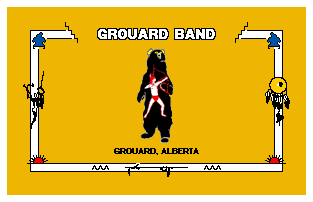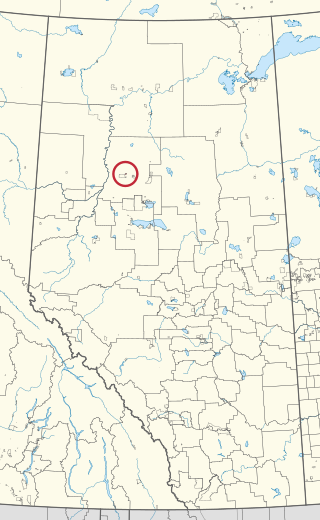
Division No. 17 is a census division in Alberta, Canada. It spans the central and northwest portions of northern Alberta and its largest urban community is the Town of Slave Lake. Division No. 17 is the largest census division in Alberta according to area and also has the lowest population density.

Alexis Elk River 233 is an Indian reserve of the Alexis Nakota Sioux Nation in Alberta, located within Yellowhead County. It is 87 kilometers southeast of Hinton.

Big Horn 144A is an Indian reserve of the Stoney Nakoda First Nation, comprising Bearspaw, Chiniki, and Wesley First Nations in Alberta, located within Clearwater County. In the 2016 Canadian Census, it recorded a population of 237 living in 44 of its 59 total private dwellings.

Boyer River 164 is an Indian reserve of the Beaver First Nation in Alberta, located within Mackenzie County. It is 16 kilometers northwest of Fort Vermilion. In the 2016 Canadian Census, it recorded a population of 218 living in 63 of its 67 total private dwellings.

Bushe River 207 is an Indian reserve of the Dene Tha' First Nation in Alberta, located within Mackenzie County. To the west, it is adjacent to the town of High Level. In the 2016 Canadian Census, it recorded a population of 503 living in 134 of its 142 total private dwellings.

Child Lake 164A is an Indian reserve of the Beaver First Nation in Alberta, located within Mackenzie County. It is 32 kilometers northwest of Fort Vermilion. The reserve takes its name from a nearby lake where a child once drowned.

Kapawe'no 150B, historically known as Freeman 150B, is an Indian reserve of the Kapawe'no First Nation in Alberta, located within Big Lakes County. It is 8 kilometers northwest of Lesser Slave Lake. In the 2016 Canadian Census, it recorded a population of 154 living in of its 45 total private dwellings.

The Kapawe'no First Nation is a band government in Alberta, Canada. It is headquartered at Grouard, Alberta, which is near High Prairie.

Sucker Creek 150A is an Indian reserve of the Sucker Creek First Nation in Alberta, located within Big Lakes County. It is 22 kilometres south of High Prairie. In the 2016 Canadian Census, it recorded a population of 689 living in 235 of its 274 total private dwellings.

Kapawe'no 150D, formerly known as Pakashan 150D, is an Indian reserve of the Kapawe'no First Nation in Alberta, located within Big Lakes County. It is 13 kilometres northwest of Lesser Slave Lake. In the 2016 Canadian Census, it recorded a population of 5 living in 4 of its 7 total private dwellings.

Kapawe'no 229 is an Indian reserve of the Kapawe'no First Nation in Alberta, located within Big Lakes County. It is 27 kilometres northeast of High Prairie.

Kapawe'no 230 is an Indian reserve of the Kapawe'no First Nation in Alberta, located within Big Lakes County. It is 25 kilometres northeast of High Prairie.

Kapawe'no 231 is an Indian reserve of the Kapawe'no First Nation in Alberta, located within Big Lakes County. It is 86 kilometres north of Swan Hills.

William McKenzie 151K is an Indian reserve of the Duncan's First Nation in Alberta, located within Northern Sunrise County. It is 33 kilometres north of McLennan.

Woodland Cree 226 is an Indian reserve of the Woodland Cree First Nation in Alberta, located within Northern Sunrise County. It is 48 kilometres northeast of Peace River. In the 2016 Canadian Census, it recorded a population of 723 living in 188 of its 211 total private dwellings.

Woodland Cree 227 is an Indian reserve of the Woodland Cree First Nation in Alberta, located within Northern Sunrise County. It is 60 kilometres northeast of Peace River.

Woodland Cree 228 is an Indian reserve of the Woodland Cree First Nation in Alberta, located within Northern Sunrise County. It is 75 kilometres northeast of Peace River. In the 2016 Canadian Census, it recorded a population of 150 living in 33 of its 36 total private dwellings.
C150, C-150 or variation, may refer to:
















